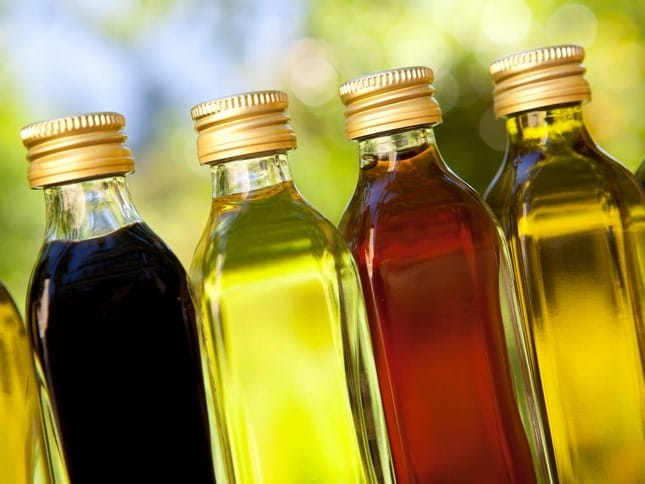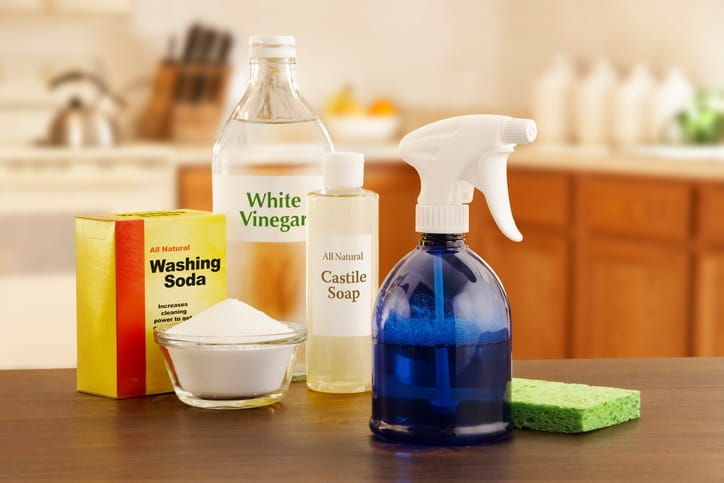No, Vinegar is Not Always Safe

The Bottom Line
Vinegar is a common ingredient in many foods. While there is some evidence that it has legitimate medicinal uses, vinegar can also cause injury if improperly used.

What is vinegar?
Vinegar, from the French vin aigre (sour wine), is a flavoring agent used in many foods. Vinegar is made by fermenting a variety of carbohydrates, including fruits, grains, honey, wine, and even potatoes. Acetic acid is one of the products of the fermentation process and gives vinegar its sharp flavor and pungent odor. In the US, white distilled vinegars are 4–7% acetic acid. Cider and wine vinegars contain 5–6% acetic acid. Acetic acid alone, however, is not vinegar. Vinegar contains many other ingredients, such as amino acids, mineral salts, and organic acids derived from the fermented source.
Herbal vinegars can be seasoned with garlic, basil, tarragon, or other herbs. Fruit vinegars are sweetened with fruit or fruit juice. A popular example of a traditional fruit vinegar is balsamic vinegar, which is made from white Trebbiano grapes fermented slowly and then aged for years in wooden casks.
Can vinegar be toxic?
There is an old saying that “the dose makes the poison.” With vinegar, the concentration of acetic acid is as important as the dose in determining toxicity. In one report, 11 Turkish children (aged 11–89 months) swallowed white vinegar containing 80% acetic acid. They developed esophageal closures that required multiple interventions to reopen, and one child died. However, most commercial vinegars produced and sold in the US contain far less acetic acid.
Vinegar was used as an anti-infective on the skin for centuries, especially before the discovery of antibiotics. People believed that vinegar’s acidity would inhibit the growth of bacteria and fungi. However, do not use vinegar to treat wounds. Vinegar is not effective against the bacteria that cause wound infections, and it can cause burns with prolonged contact.
If vinegar gets into the eyes, irritation and redness are common, and corneal injury can occur. The eyes should be rinsed immediately. Remove contact lenses and use lots of room-temperature water. For children, pour water onto the bridge of the nose and let it gently run into the eyes. Encourage blinking. Then, check with Poison Control after rinsing.
Does vinegar help jellyfish stings?
Some sources recommend pouring vinegar on jellyfish stings. However, medical evidence is inconsistent regarding vinegar’s ability to relieve pain, inactivate toxins, or prevent further release of nematocysts. Nematocysts are tiny tubes injected by jellyfish containing spines and toxins used to capture and paralyze prey.
In studies evaluating treatments for jellyfish stings, the use of vinegar got mixed results. In one study, pouring vinegar over the affected skin provided some relief from stings by the Australian box jellyfish. Another study supported vinegar use for the treatment of stings by a jellyfish found only in the South Atlantic. However, vinegar might cause nematocyst discharge in some North American jellyfish. In other words, vinegar can actually prove harmful in some instances. There is no good evidence that vinegar is beneficial in treating jellyfish stings likely to occur along US coastlines.
Is apple cider vinegar good for you?
Apple cider vinegar products are advertised for weight loss, high blood pressure, arthritis, aging, and type 2 (non-insulin-dependent) diabetes. Small studies suggest that apple cider vinegar pills, pickles, or liquid vinegar might help in some people with type 2 diabetes by reducing spikes in blood sugar that follow meals. Scientists are still figuring out exactly how this works. People with diabetes should not self-treat with vinegar and should discuss any diabetes treatment with their healthcare providers before using it.
Is it safe to mix bleach and vinegar?
Vinegar is sometimes used as part of home cleaning solutions. You should never mix vinegar with chlorine bleach. The combination creates highly irritating chlorine gas.
What to do if you are concerned about possible vinegar poisoning.
If someone swallows vinegar, splashes vinegar in their eyes, or if you have a question about using vinegar safely, help from experts is available through the webPOISONCONTROL online tool and by phone at 1-800-222-1222. Poison Control’s expert guidance is always free, confidential, and available 24 hours a day.
Mary Elizabeth May, RN, BA, MPH
Certified Specialist in Poison Information
Revised William G. Troutman, PharmD
Professor of Pharmacy Emeritus
Poison Control Media Information
Did you find this page helpful? If so, we need your support. Poison Control is in constant competition with misinformation online. Links to www.poison.org or our webPOISONCONTROL triage tool from other websites and blogs help internet searchers quickly find accurate information and Poison Control’s contact information in an emergency. If you use the content from this page, please provide attribution via a link back to this page, www.poison.org, or https://triage.webpoisoncontrol.org/#!/exclusions. By doing so, you could save a life. Thank you!
Poisoned?
Call 1-800-222-1222 or
Prevention Tips
- Keep vinegar and dietary supplements containing vinegar away from children.
- Do not attempt to treat fevers, sunburns, or other conditions by applying vinegar compresses to the skin. This can cause burns.
- Do not mix vinegar with chlorine bleach. This results in the release of chlorine gas that is very irritating to the airways, eyes, nose, and throat.
- Do not use dietary supplements containing vinegar without the approval of your healthcare provider.
This Really Happened
Case 1. A 48-year-old woman swallowed an apple cider vinegar tablet and developed severe pain and trouble swallowing when the tablet became lodged in her throat. Although an endoscopy performed 2 weeks later found nothing, she still had pain and trouble swallowing 6 months after the incident (from Hill et al., 2005).
Case 2. A 25-day-old boy with a fever suffered first-degree burns on his neck, shoulders, chest, and back after his grandmother applied compresses soaked in grape vinegar (5% acetic acid) to lower his body temperature. After 2 days of treatment in the hospital, his burns began to fade, and disappeared within 10 days without scarring (from Korkmaz et al., 2000).
Case 3. A 59-year-old woman twisted her ankle while mountain climbing. She covered her ankle with a homemade poultice made of gauze soaked in a 50/50 mixture of flour vinegar and rice vinegar, containing 4–5% acetic acid. She kept the gauze on for 2 hours. When she removed it, the area was dark red and partially brown-black and swollen. She required hospitalization and received a skin graft about a month later (from Kuniyuki & Oonishi, 1997).
Case 4. A 25-year-old woman mixed bleach and vinegar to clean her kitchen. Very irritating fumes developed. Her chest burned and she had a runny nose. She called Poison Control and was advised to fill her bathroom with steam by running a hot shower and to inhale the warm, humid air for 15–20 minutes at a time while drinking fluids. She still had chest soreness that night but no trouble breathing. The next day, when Poison Control checked back on her, the symptoms had resolved.
Case 5. A 45-year-old man unintentionally splashed vinegar into his eye. He flushed his eye in the shower, but 2 days later he still had irritation and blurred vision. He then called Poison Control and was referred to an ophthalmologist. The ophthalmologist found small scratches on his cornea. He was treated with antibiotic eye drops. Poison Control called him regularly, and his symptoms resolved in 4 days.
For More Information
Benisek A. Apple cider vinegar. WebMD. Reviewed July 7, 2023. Accessed January 6, 2024.References
Atıcı A, Miçooğulları L, Uğur B, Çelikkaya ME, Akçora B. Accidental ingestion of concentrated white vinegar in Hatay children in Turkey. Arh Hig Rada Toksikol. 2023;74(4):288–291.
Elhage KG, St Claire K, Daveluy S. Acetic acid and the skin: a review of vinegar in dermatology. Int J Dermatol. 2022;61(7):804–811.
Hill LL, Woodruff LH, Foote JC, Barreto-Alcoba M. Esophageal injury by apple cider vinegar tablets and subsequent evaluation of products. J Am Diet Assoc. 2005;105(7):1141–1144.
Johnston CS, Gaas CA. Vinegar: medicinal uses and antiglycemic effect. MedGenMed. 2006;8(2):61.
Korkmaz A, Sahiner U, Yurdakök M. Chemical burn caused by topical vinegar application in a newborn infant. Pediatr Dermatol. 2000;17(1):34–36.
Kuniyuki S, Oonishi H. Chemical burn from acetic acid with deep ulceration. Contact Dermatitis. 1997;36(3):169–170.
McGee RG, Webster AC, Lewis SR, Welsford M. Interventions for the symptoms and signs resulting from jellyfish stings. Cochrane Database Syst Rev. 2023;6(6):CD009688.
Shishehbor F, Mansoori A, Shirani F. Vinegar consumption can attenuate postprandial glucose and insulin responses; a systematic review and meta-analysis of clinical trials. Diabetes Res Clin Pract. 2017;127:1-9.
Ward NT, Darracq MA, Tomaszewski C, Clark RF. Evidence-based treatment of jellyfish stings in North America and Hawaii. Ann Emerg Med. 2012;60(4):399–414.
Poisoned?
Call 1-800-222-1222 or
Prevention Tips
- Keep vinegar and dietary supplements containing vinegar away from children.
- Do not attempt to treat fevers, sunburns, or other conditions by applying vinegar compresses to the skin. This can cause burns.
- Do not mix vinegar with chlorine bleach. This results in the release of chlorine gas that is very irritating to the airways, eyes, nose, and throat.
- Do not use dietary supplements containing vinegar without the approval of your healthcare provider.
This Really Happened
Case 1. A 48-year-old woman swallowed an apple cider vinegar tablet and developed severe pain and trouble swallowing when the tablet became lodged in her throat. Although an endoscopy performed 2 weeks later found nothing, she still had pain and trouble swallowing 6 months after the incident (from Hill et al., 2005).
Case 2. A 25-day-old boy with a fever suffered first-degree burns on his neck, shoulders, chest, and back after his grandmother applied compresses soaked in grape vinegar (5% acetic acid) to lower his body temperature. After 2 days of treatment in the hospital, his burns began to fade, and disappeared within 10 days without scarring (from Korkmaz et al., 2000).
Case 3. A 59-year-old woman twisted her ankle while mountain climbing. She covered her ankle with a homemade poultice made of gauze soaked in a 50/50 mixture of flour vinegar and rice vinegar, containing 4–5% acetic acid. She kept the gauze on for 2 hours. When she removed it, the area was dark red and partially brown-black and swollen. She required hospitalization and received a skin graft about a month later (from Kuniyuki & Oonishi, 1997).
Case 4. A 25-year-old woman mixed bleach and vinegar to clean her kitchen. Very irritating fumes developed. Her chest burned and she had a runny nose. She called Poison Control and was advised to fill her bathroom with steam by running a hot shower and to inhale the warm, humid air for 15–20 minutes at a time while drinking fluids. She still had chest soreness that night but no trouble breathing. The next day, when Poison Control checked back on her, the symptoms had resolved.
Case 5. A 45-year-old man unintentionally splashed vinegar into his eye. He flushed his eye in the shower, but 2 days later he still had irritation and blurred vision. He then called Poison Control and was referred to an ophthalmologist. The ophthalmologist found small scratches on his cornea. He was treated with antibiotic eye drops. Poison Control called him regularly, and his symptoms resolved in 4 days.
